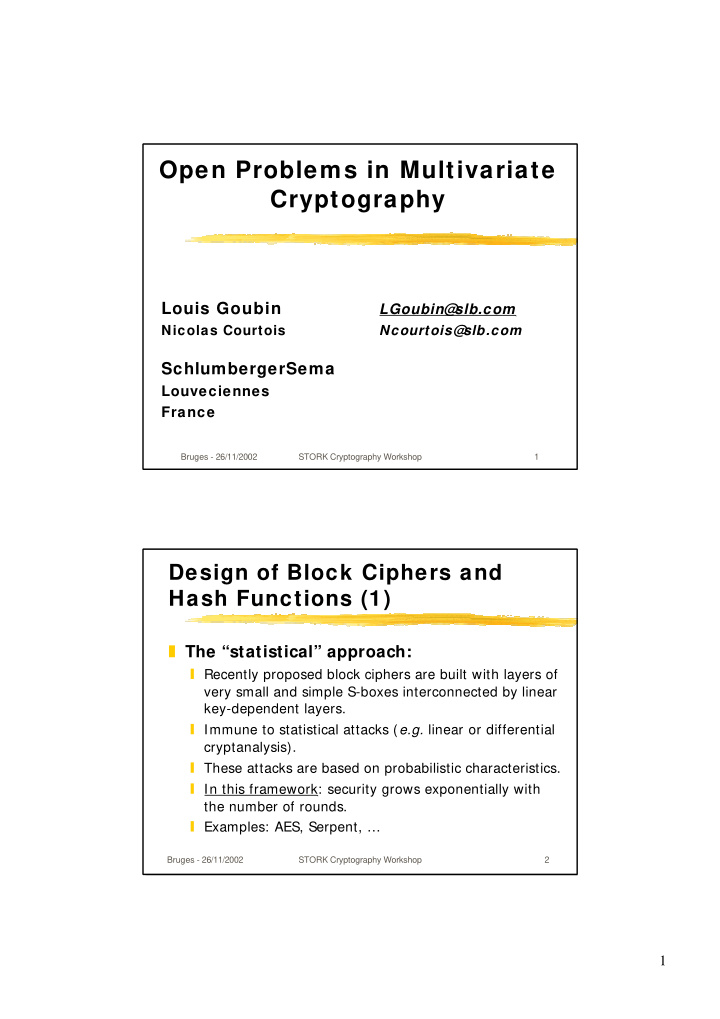



Open Problems in Multivariate Cryptography Louis Goubin LGoubin@ slb.com Nicolas Courtois Ncourtois@ slb.com SchlumbergerSema Louveciennes France Bruges - 26/11/2002 STORK Cryptography Workshop 1 Design of Block Ciphers and Hash Functions (1) T The “statistical” approach: S Recently proposed block ciphers are built with layers of very small and simple S-boxes interconnected by linear key-dependent layers. S Immune to statistical attacks ( e.g. linear or differential cryptanalysis). S These attacks are based on probabilistic characteristics. S In this framework: security grows exponentially with the number of rounds. S Examples: AES, Serpent, … Bruges - 26/11/2002 STORK Cryptography Workshop 2 1
Design of Block Ciphers and Hash Functions (2) T The “algebraic” approach: S Breaking a cipher should require “as much work as solving a system of simultaneous equations in a large number of unknowns of a complex type” [Shannon, 1949] S Common belief: large systems of equations become intractable very easily. S However: what makes the problem hard to solve is not the number of variables, but the balance between the number of equations and the number of monomials: R The XL method [Shamir, Patarin, Courtois, Klimov, Eurocrypt’2000] R The XSL variant [Courtois, Pieprzyk, Asiacrypt’2002] S Consequence: systems that are overdefined, sparse, or both, turn out to be much easier to solve than expected. Bruges - 26/11/2002 STORK Cryptography Workshop 3 Design of Block Ciphers and Hash Functions (3) T This questions the security of numerous block ciphers, e.g. AES [ Courtois, Pieprzyk 2002] [Murphy, Robshaw 2002] T Several problems remain to be solved: S Study the behaviour of the XL algorithm on random systems of equations. S Can XL be subexponential on average ? S Study the relations between the XL algorithm and Gröbner bases algorithms. S Study the XSL algorithm on random systems of equations. S Study the XSL algorithm on systems of equations derived from block ciphers. S Evaluate the security of AES and Serpent. Bruges - 26/11/2002 STORK Cryptography Workshop 4 2
Design of Stream Ciphers and Pseudorandom Generators (1) T Stream ciphers are usually composed of two components : S One is simple and linear: to produce a sequence with a large period. S One is non-linear: to alter the simple periodic sequences. T Most of current research: optimal disguising of the linear part , by using non-linearity criteria: S High algebraic degree S Large distance from the set of all affine functions Bruges - 26/11/2002 STORK Cryptography Workshop 5 Design of Stream Ciphers and Pseudorandom Generators (2) T However, in many current stream ciphers: S The output can be given as a simple multivariate equation in the key bits S The attacker may dispose of an important quantity of keystream. S � Highly overdefined systems of multivariate equations to solve. T Realistic attacks: S Toyocrypt: attack in 2 39 [Courtois, Meier 2002] S Lili-128: attack in 2 57 [Courtois, 2002] Bruges - 26/11/2002 STORK Cryptography Workshop 6 3
Design of Stream Ciphers and Pseudorandom Generators (3) T Several problems remain to be solved: S Study the behaviour of XL on systems of equations of degree > 2. S Study methods to find higher-order approximations by boolean functions, also known as polynomial learning in presence of noise, or decoding Reed- Muller codes. S Study methods to lower the degree of system of multivariate equations (for example by adding additional variables). S Propose new design criteria on stream ciphers, as done for block ciphers [Courtois, Pieprzyk 2002] Bruges - 26/11/2002 STORK Cryptography Workshop 7 4
Recommend
More recommend